DigiCert Leads Initiative to Enhance EV SSL Certificates
In collaboration with several other certificate authorities, DigiCert has proposed 4 enhancements to the EV SSL validation processes

“On the Internet, nobody knows you’re a dog.”
Cartoonist Peter Steiner penned those words in a cartoon strip all the way back in 1993. The cartoon was funny and made a lot of people laugh, but it was highlighting a serious issue that was just developing back then—how easy it was to trick people via the anonymity of the internet. Unfortunately, Peter nailed it! Today, that problem is even bigger than anyone – even Peter – could have imagined—1 in 25 branded emails is actually a phishing email.
So, why is online identity so important? How will DigiCert’s
proposal help consumers?
Let’s hash it out.
Why Online Identity Is So Important
The internet is flooded with unknown actors, and a lot of
times they’re up to nefarious activities—phishing, bullying, catfishing, scamming,
preying on children, swatting, and more. That’s why most internet users tend to
be suspicious of interactions with people, websites, and companies they don’t
know—typically, we want to know the real-world identity of the individuals and
companies we interact with online.
What would you think if you went to your local shopping
center and saw a shop with no business name, like this?

You’d be intrigued — but you probably wouldn’t trust that company. You’d certainly have some questions! Customers don’t trust anonymity — they want to know who they’re doing business with.
The same thing is true online — customers want to know who they’re buying from. At your local mall, it’s pretty easy to tell who you’re buying from — there’s a physical store with signage and staff right in front of you. Online, though, identity can be… slippery. As Steiner pointed out, you can be a dog, a scammer, or a predator… and nobody will know until it’s too late.
In an environment saturated with anonymous trouble-makers, EV SSL is a great tool consumers can use to confidently see who runs a website, helping them decide whether to trust the website owner or not. That’s why we strongly support making EV SSL as strong and usable as possible — people want/need what it can provide. And that’s why we’re excited to see DigiCert leading the charge to update and enhance EV SSL.
DigiCert’s 4-Pronged Proposal to Enhance EV SSL
DigiCert is proposing four specific ways to update and enhance the CA/B Forum standards for EV SSL certificates. These enhancements will make EV SSL stronger and satisfy some “weaknesses” pointed out by security researchers. Let’s go through each of them, and see how they’ll help improve online identity for all:
1. Enforce Validation Level via CAA Records
A CAA record is a DNS entry that lets website managers restrict which CAs may issue certificates for their domain. It’s a great tool for fighting shadow IT certificates — ensuring that an organization’s certificates are centrally managed and authorized.
But currently CAA records can only specify certificate
authorities. DigiCert is proposing expanding CAA records so domain admins can control
or restrict the validation level of certificates that can be issued for their
domain. For example, a website admin could restrict their domain to only issue EV
SSL certificates from a certain CA.
Why This Is Beneficial:
Let’s look at a hypothetical scenario. Let’s say example.com hires a freelance web designer to update their blog with a fresh, new design for 2020. That designer isn’t authorized to issue SSL certificates for the domain. But let’s say the website designer installs a WordPress file editor plugin, so they can complete domain control validation and get an SSL certificate issued. Example.com now has an SSL certificate issued by an unauthorized party — they don’t control the certificate or the private key, which is a significant security issue. What happens when the certificate expires?
If example.com had implemented a CAA record that restricted
the domain to EV certificates from DigiCert CA only, the web designer wouldn’t
have been able to get that certificate issued because any attempt to get a
certificate type not identified in the CAA record would fail.
2. Include LEI Data in SSL Certificates
If you’ve got a feeling of déjà vu right now, it might be because we mentioned this idea back in October 2019. TL;DR:
LEIs are Legal Entity Identifiers, they were created in the aftermath of the financial crisis that occurred a decade ago. They are numerical codes recognized by 150 different countries. The entire system is overseen by a Swiss non-profit called GLEIF. An LEI can help prevent collisions and confusion. Now, I can already hear the objections percolating, that, like confusing organizational names, people won’t know what to do with an LEI number. But there are several workarounds for that. For one, the browser could just use the LEI code and generate the associated information. Granted that might require an additional call, which may be anathema to browsers – but it’s an option. You could also make it easy to click on the LEI number and follow it to a database with the information. This would require the user to take an action, but some might find it useful. But more than anything, it could send up a red flag when an eCommerce website or some other organization that transacts in valuable data DOESN’T have an LEI.”
Why This Is Beneficial:
Adding LEIs to EV SSL certificates offers two key benefits:
- adds additional information about the
organization, and - provides consumers a direct way to research and
verify company details for myriad reasons.
If you look up a company in the LEI database, you’ll get a
report with a lot of details about the organization. Starting with basic info:
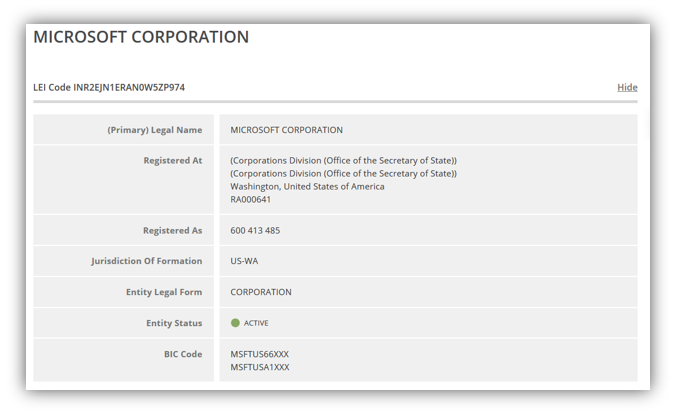
And even including information about subsidiaries and parent
companies:
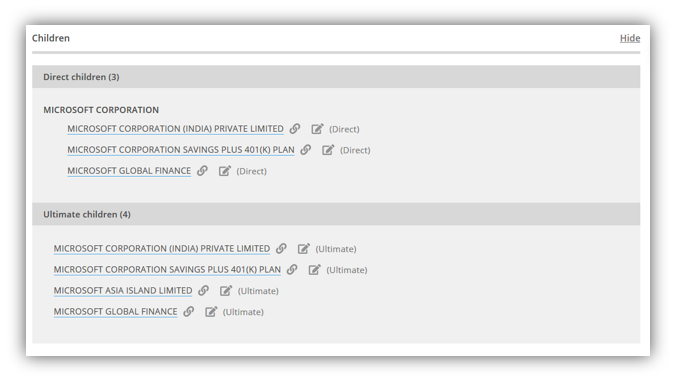
In the end, this info is ripe for being used as another data
point to solve any corporate identity assurance use case. Like EV SSL, the
infrastructure is already in place, why not use it (or at least consider it) for
resolving such an apparent problem?
3. Standardize Data Sources for EV Validation
Under the current EV guidelines, each certificate authority decides what data sources they will use for validation of organization details in EV SSL certificates. (Keeping in mind that they’re validating organizations across hundreds of countries, there can be a lot of variation in the quality of data sources being used from country to county.) DigiCert is proposing that the CA/B forum specify a standardized list of acceptable data sources to use in the EV validation process.
Why This Is Beneficial:
Using standardized data sources will offer several benefits:
- improve the consistency and speed of EV validation,
- close some potential gaps bad actors could use,
and - this could be used as a basis to deal with
naming collisions (which has been one of the criticisms against EV—for de
minimis reasons if you ask me.)
4. Include Trademark Verification During EV Validation
Since EV SSL certificates are all about showing customers
the verified identity of the organizations they’re interacting with, trademarks
are a logical add-on. As DigiCert’s Dean Coclin explains:
Trademarks are well known, understood, unique and can be validated. Consumers recognize them and so if a browser wanted to include the trademark in their UI, they could do so with confidence that it had been properly validated. If they don’t, that’s fine, but it would be in the cert for any relying party to examine.”
Why This Is Beneficial:
Trademarks are another way for consumers to be sure they’re interacting with the company they think they are. For example, Windex is a trademark owned by the SC Johnson company. But many consumers probably don’t know the Windex brand is actually owned by SC Johnson. The current EV guidelines state that it can only say SC Johnson. However, if their EV SSL certificate displayed the Windex trademark, that might help a consumer be more confident that they’re on the official and intended website.
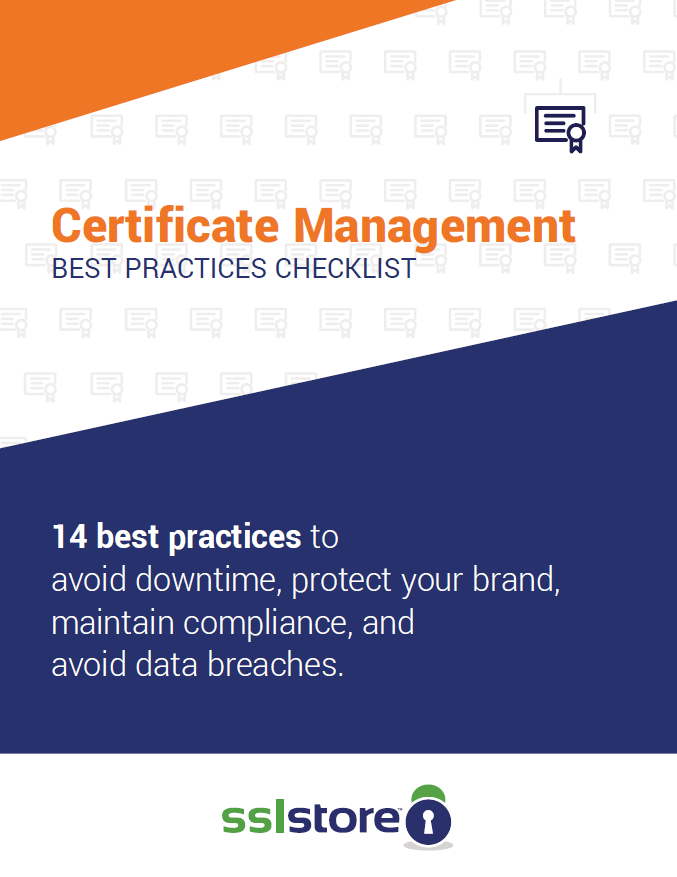
Manage Digital Certificates like a Boss
14 Certificate Management Best Practices to keep your organization running, secure and fully-compliant.
The Other Part Of The Equation: Browsers’ Need An Effective UI To Display
Website Identity Information
Ultimately, for EV SSL certificates to reach their full
potential in helping users, the browsers need to research, identify and
introduce a more effective interface for displaying identity information to
users. (Incidentally, the browser’s identity interface wouldn’t have to be
limited to data from EV—it could contain data from other verified sources to
provide consumers all the data they need to make an informed decision.)
Since Chrome and Firefox removed the old “green address bar”
due to concerns that it wasn’t effective, the onus is on the browsers to
develop a new UI that helps users understand who is running the websites
they’re interacting with. In my opinion, removing EV without replacing it with
a viable alternative did the world a huge disservice. EV may not have helped 100%
of internet users, but it certainly helped more than 0%. It wasn’t perfect, but
it was all the internet had. It’s like saying, since automobile accidents still
happen at intersections, get rid of all traffic lights until we think of
something better. For some reason, logic just seemed to go out the window on
this one.
It doesn’t seem like too big of an ask for the browser
community to seriously come together and help create a universal display that
will help consumers with the identity of websites that they interact with. I
think if browsers put their users’ interests first, the answer will come very
easily.
Social Media Sites Have Already Created a UI for Online Identity, Let’s
Learn From Them!
I took 15 minutes with my team and came up with a half-baked
idea that seems to make quick sense. One of the big things that the EV
naysayers harped on was that the “green address bar” needed education to
understand what it actually meant. They believed that it should require no
training or education and that it should just be immediately understood. Well,
in minute three of our discussion, we realized that all of the social media channels
over the past decade have already educated the world on this exact problem. The
social media eco-system recognized issues with identity and addressed it
head-on years ago by introducing the verified account status symbol. A verified
account status is reserved for high-profile accounts of companies, brands or
individuals that are especially vulnerable to impersonation.
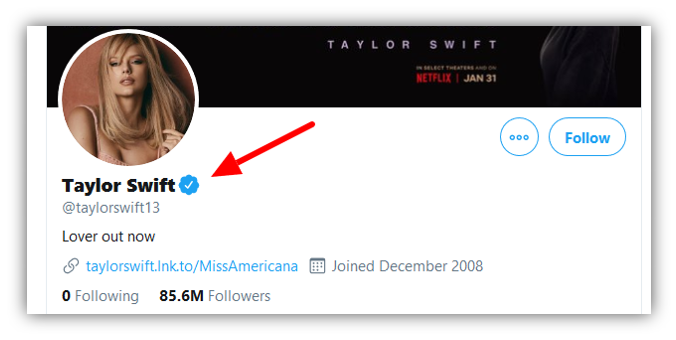
For obvious reasons, fake accounts that are used to
impersonate a popular user on a social media platform could easily cause
irreparable brand damage to both the real account holder and the platform’s
business model. That’s specifically why the verified account status and symbol
exist. Well, since the social media channels have already done the educating
and have fully conditioned users at scale to look for verified account symbols
when consuming content, why not adopt that developed behavior to work in
browser environments? It can quickly be used to address online identity on a
wider scale than just social media. Seems like the logical next step. Does it somehow
go against browser business models?
Below is what we came up with over a cup of coffee. For DV
SSL, since the lock doesn’t mean what it used to, simply hide it. Then let’s
introduce two, or maybe just one, verified website symbol. I’d bet that if you
did a study, users would immediately understand what this means. Without
education. With conviction.
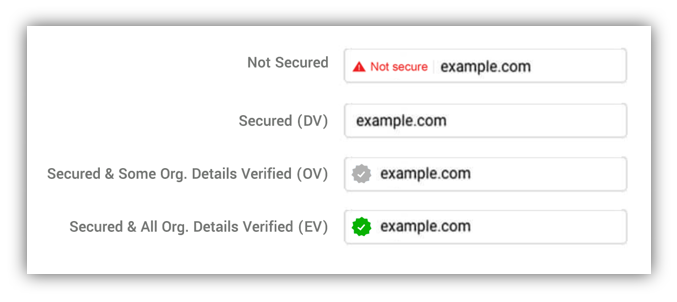
Mousing over the verified icon could display a tooltip
showing more specifics on what the icon means.

If you click on it, something like this could display. It’s
very similar to what used to be displayed, but with a few tweaks.
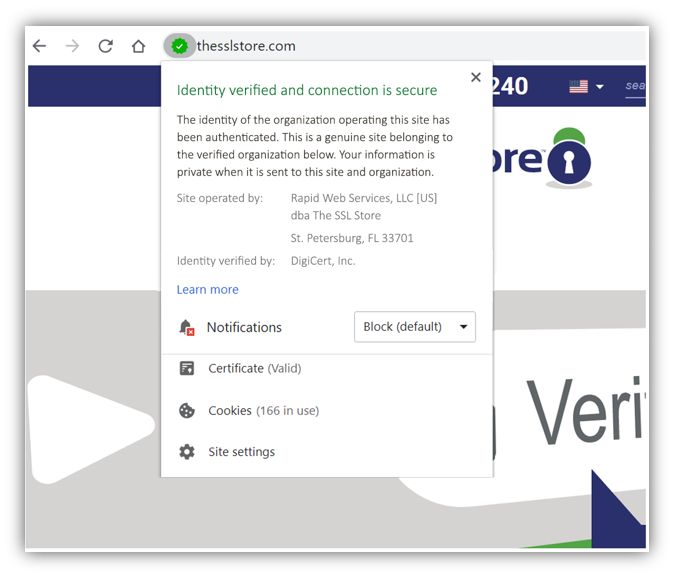
Just to reiterate, this idea would be after the EV guidelines have been enhanced. I’m sure there are more things worth consideration, but this took us 15 minutes in an informal meeting setting. I wonder what a group of browser security experts and security researchers could come up with if they tried to solve online identity head on… for the sake of Internet users. At the least, it’s worthy of a real discussion where all parties come together to really solve a larger issue for the greater good of society. Not just go through the motions.
On the Internet, nobody knows you’re a legit website.
DigiCert is trying to do something about it. Browsers, you’re up.
*** This is a Security Bloggers Network syndicated blog from Hashed Out by The SSL Store™ authored by Bill Grueninger. Read the original post at: https://www.thesslstore.com/blog/digicert-leads-initiative-to-enhance-ev-ssl-certificates/





